 W
WBlack ice, sometimes called clear ice, is a thin coating of glaze ice on a surface, especially on roads. The ice itself is not black, but visually transparent, allowing the often black road below to be seen through it. The typically low levels of noticeable ice pellets, snow, or sleet surrounding black ice means that areas of the ice are often practically invisible to drivers or people stepping on it. There is, thus, a risk of slippage and subsequent accident due to the unexpected loss of traction.
 W
WA blizzard is a severe snowstorm characterized by strong sustained winds of at least 56 km/h (35 mph) and lasting for a prolonged period of time—typically three hours or more. A ground blizzard is a weather condition where snow is not falling but loose snow on the ground is lifted and blown by strong winds. Blizzards can have an immense size and usually stretch to hundreds or thousands of kilometres.
 W
WBloop was an ultra-low-frequency, high amplitude underwater sound detected by the U.S. National Oceanic and Atmospheric Administration (NOAA) in 1997. By 2012, earlier speculation that the sound originated from a marine animal was replaced by NOAA's description of the sound as being consistent with noises generated via non-tectonic cryoseisms originating from glacial movements such as ice calving, or through seabed gouging by ice.
 W
WCrown snow-load is snow and/or hard rime that accumulates on tree crowns in a cold climate. There are two main climatic conditions in which this phenomenon chiefly takes place. Hard rime is formed when subcooled droplets of fog or low level cloud (Stratus) freeze on the windward (wind-facing) side of tree branches, buildings, or any other solid objects. This takes place usually with moderate wind velocities from 3 m/s to 6 m/s and air temperatures between -2 °C (28 °F) and -8 °C (18 °F). Snow may accumulate directly on the trees when a warm front brings wet snow, the air temperature is slightly above the freezing point and the surface of the tree is colder due to a preceding cold spell.
 W
WIce crystals are solid ice exhibiting atomic ordering on various length scales and include hexagonal columns, hexagonal plates, dendritic crystals, and diamond dust.
 W
WDiamond dust is a ground-level cloud composed of tiny ice crystals. This meteorological phenomenon is also referred to simply as ice crystals and is reported in the METAR code as IC. Diamond dust generally forms under otherwise clear or nearly clear skies, so it is sometimes referred to as clear-sky precipitation. Diamond dust is most commonly observed in Antarctica and the Arctic, but can occur anywhere with a temperature well below freezing. In the polar regions of Earth, diamond dust may persist for several days without interruption.
 W
WFog is a visible aerosol consisting of tiny water droplets or ice crystals suspended in the air at or near the Earth's surface. Fog can be considered a type of low-lying cloud usually resembling stratus, and is heavily influenced by nearby bodies of water, topography, and wind conditions. In turn, fog has affected many human activities, such as shipping, travel, and warfare.
 W
WFrazil ice is a collection of loose, randomly oriented, plate or discoid ice crystals formed in supercooled turbulent water. Its formation is common during the winter in rivers and lakes located in northern latitudes, and usually forms in open-water reaches of rivers where and when the heat exchange between the air and the water is such that the water temperature can drop below its freezing point. As a rule of thumb, such conditions may happen on cold and clear nights, when the air temperature is lower than −6 °C (21 °F). Frazil ice also forms in oceans, where it is often referred to as grease ice when floating on the surface.
 W
WFreezing rain is the name given to rain maintained at temperatures below freezing by the ambient air mass that causes freezing on contact with surfaces. Unlike a mixture of rain and snow, ice pellets, or hail, freezing rain is made entirely of liquid droplets. The raindrops become supercooled while passing through a sub-freezing layer of air hundreds of meters above the ground, and then freeze upon impact with any surface they encounter, including the ground, trees, electrical wires, aircraft, and automobiles. The resulting ice, called glaze ice, can accumulate to a thickness of several centimeters and cover all exposed surfaces. The METAR code for freezing rain is FZRA.
 W
WA frost flower is formed when thin layers of ice are extruded from long-stemmed plants in autumn or early winter. The thin layers of ice are often formed into exquisite patterns that curl into "petals" that resemble flowers.
 W
WFrost flowers are ice crystals commonly found growing on young sea ice and thin lake ice in cold, calm conditions. The ice crystals are similar to hoar frost, and are commonly seen to grow in patches around 3–4 cm in diameter. Frost flowers growing on sea ice have extremely high salinities and concentrations of other sea water chemicals and, because of their high surface area, are efficient releasers of these chemicals into the atmosphere.
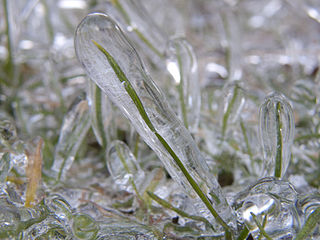 W
WGlaze or glaze ice, also called glazed frost, is a smooth, transparent and homogeneous ice coating occurring when freezing rain or drizzle hits a surface. It is similar in appearance to clear ice, which forms from supercooled water droplets. It is a relatively common occurrence in temperate climates in the winter when precipitation forms in warm air aloft and falls into below-freezing temperature at the surface.
 W
WGraupel, also called soft hail or snow pellets, is precipitation that forms when supercooled water droplets are collected and freeze on falling snowflakes, forming 2–5 mm (0.08–0.20 in) balls of rime. The term graupel is the German language word for sleet.
 W
WGrease ice is a very thin, soupy layer of frazil crystals clumped together, which makes the ocean surface resemble an oil slick. Grease ice is the second stage in the formation of solid sea ice after ice floes and then frazil ice.
 W
WGround blizzard refers to a weather condition where loose snow or ice on the ground is lifted and blown by strong winds. This can occur in the absence of precipitation, and can even occur when the sky is clear. This is in contrast to "ordinary" blizzards, which are accompanied by heavy falling snow. They can be especially dangerous as they occur after a winter storm has passed, when it is assumed that all forms of severe winter weather has ended.
 W
WGround frost refers to the various coverings of ice produced by the direct deposition of water vapor on objects and trees, whose surfaces have a temperature below the freezing point of water.
 W
WHail is a form of solid precipitation. It is distinct from ice pellets, though the two are often confused. It consists of balls or irregular lumps of ice, each of which is called a hailstone. Ice pellets fall generally in cold weather while hail growth is greatly inhibited during cold surface temperatures.
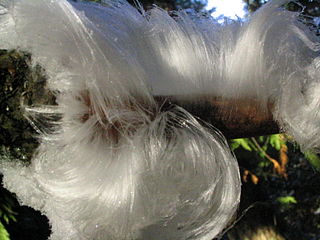 W
WHair ice, also known as ice wool or frost beard, is a type of ice that forms on dead wood and takes the shape of fine, silky hair. It is somewhat uncommon, and has been reported mostly at latitudes between 45–55 °N in broadleaf forests. The meteorologist and discoverer of continental drift, Alfred Wegener, described hair ice on wet dead wood in 1918, assuming some specific fungi as the catalyst, a theory mostly confirmed by Gerhart Wagner and Christian Mätzler in 2005. In 2015, the fungus Exidiopsis effusa was identified as key to the formation of hair ice.
 W
WThe ice circle of Vana-Vigala is a natural phenomenon appearing on the Vigala River in Estonia while the river freezes.
 W
WAn ice dune, also called an ice ridge or an ice foot, is a formation of ice that accumulates on the shores of many arctic beaches and is also common along the shores of the Great Lakes during the winter.
 W
WIce pellets are a form of precipitation consisting of small, translucent balls of ice. Ice pellets are smaller than hailstones which form in thunderstorms rather than in winter, and are different from graupel which is made of frosty white rime, and from a mixture of rain and snow which is a slushy liquid or semisolid. Ice pellets often bounce when they hit the ground or other solid objects, and make a higher-pitched "tap" when striking objects like jackets, windshields, and dried leaves, compared to the dull splat of liquid raindrops. Pellets generally do not freeze into a solid mass unless mixed with freezing rain. The METAR code for ice pellets is PL.
 W
WAn ice sheet, also known as a continental glacier, is a mass of glacial ice that covers surrounding terrain and is greater than 50,000 km2 (19,000 sq mi). The only current ice sheets are in Antarctica and Greenland; during the last glacial period at Last Glacial Maximum (LGM) the Laurentide Ice Sheet covered much of North America, the Weichselian ice sheet covered northern Europe and the Patagonian Ice Sheet covered southern South America.
 W
WAn ice shelf is a large floating platform of ice that forms where a glacier or ice sheet flows down to a coastline and onto the ocean surface. Ice shelves are only found in Antarctica, Greenland, Canada, and the Russian Arctic. The boundary between the floating ice shelf and the anchor ice that feeds it is the grounding line. The thickness of ice shelves can range from about 100 m (330 ft) to 1,000 m (3,300 ft).
 W
WAn ice shove, ice surge, ice heave, ivu, or shoreline ice pileup is a surge of ice from an ocean or large lake onto the shore. Ice shoves are caused by ocean currents, strong winds, or temperature differences pushing ice onto the shore, creating piles up to 12 metres high. Some have described them as 'ice tsunamis', but the phenomenon works like an iceberg. Witnesses have described the shove's sound as being like that of a train or thunder. Ice shoves can damage buildings and plants that are near to the body of water. Arctic communities can be affected by ice shoves.
 W
WAn ice spike is an ice formation, often in the shape of an inverted icicle, that projects upwards from the surface of a body of frozen water. Ice spikes created by natural processes on the surface of small bodies of frozen water have been reported for many decades, although their occurrence is quite rare. A mechanism for their formation, now known as the Bally–Dorsey model, was proposed in the early 20th century but this was not tested in the laboratory for many years. In recent years a number of photographs of natural ice spikes have appeared on the Internet as well as methods of producing them artificially by freezing distilled water in domestic refrigerators or freezers. This has allowed a small number of scientists to test the hypothesis in a laboratory setting and, although the experiments appear to confirm the validity of the Bally–Dorsey model, they have raised further questions about how natural ice spikes form, and more work remains to be done before the phenomenon is fully understood. Natural ice spikes can grow into shapes other than a classic spike shape, and have been variously reported as ice candles, ice towers or ice vases as there is no standard nomenclature for these other forms. One particularly unusual form takes the shape of an inverted pyramid.
 W
WAn ice storm is a type of winter storm characterized by freezing rain, also known as a glaze event or, in some parts of the United States, as a silver thaw. The U.S. National Weather Service defines an ice storm as a storm which results in the accumulation of at least 0.25-inch (6.4 mm) of ice on exposed surfaces. From 1982 to 1994, ice storms were more common than blizzards in the U.S., averaging 16 per year. They are generally not violent storms but instead are commonly perceived as gentle rains occurring at temperatures just below freezing.
 W
WAn ice volcano is a conical mound of ice formed over a terrestrial lake via the eruption of water and slush through an ice shelf. The process is wave-driven, with wind providing the energy for the waves to cut through the ice and form the so-called volcanoes. After being ejected into the atmosphere, the liquid water and slush freeze and fall back to the surface, growing the formation. Ice may also be erupted. The phenomenon is most often observed along the southern coast of Lake Erie and Lake Ontario, when the temperature is below freezing and the wind blows onshore with a velocity of at least 25 mph (40 km/h). They are known to reduce coastal erosion there. The formations are temporary — they are frequently destroyed by storms and warm weather, and once the lake wholly freezes over, eruptions are no longer possible.
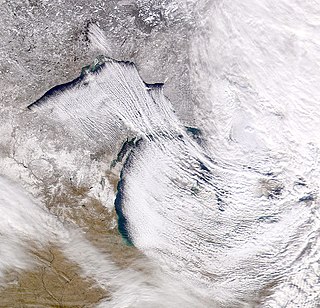 W
WLake-effect snow is produced during cooler atmospheric conditions when a cold air mass moves across long expanses of warmer lake water. The lower layer of air, heated up by the lake water, picks up water vapor from the lake and rises up through the colder air above; the vapor then freezes and is deposited on the leeward (downwind) shores.
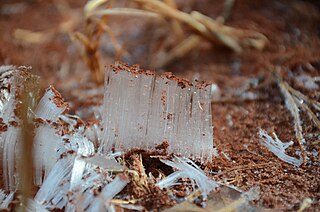 W
WNeedle ice is a needle-shaped column of ice formed by groundwater. Needle ice forms when the temperature of the soil is above 0 °C (32 °F) and the surface temperature of the air is below 0 °C (32 °F). Liquid water underground rises to the surface by capillary action, and then freezes and contributes to a growing needle-like ice column.
 W
WA pressure ridge develops in an ice cover as a result of a stress regime established within the plane of the ice. Within sea ice expanses, pressure ridges originate from the interaction between floes, as they collide with each other. Currents and winds are the main driving forces, but the latter are particularly effective when they have a predominant direction. Pressure ridges are made up of angular ice blocks of various sizes that pile up on the floes. The part of the ridge that is above the water surface is known as the sail; that below it as the keel. Pressure ridges are the thickest sea ice features and account for about one-half of the total sea ice volume. Stamukhi are pressure ridges that are grounded and that result from the interaction between fast ice and the drifting pack ice.
 W
WRain and snow mixed is precipitation composed of rain and partially melted snow. Unlike ice pellets, which are hard, and freezing rain, which is fluid until striking an object, this precipitation is soft and translucent, but it contains some traces of ice crystals, from partially fused snowflakes. In any one location, it usually occurs briefly as a transition phase from rain to snow or vice versa. Its METAR code is RASN.
 W
WRime ice forms when supercooled water liquid droplets freeze onto surfaces. Meteorologists distinguish between three basic types of ice forming on vertical and horizontal surfaces by deposition of supercooled water droplets. There are also intermediate formations.Soft rime is less dense than hard rime and is milky and crystalline, like sugar. Soft rime appears similar to hoar frost. Hard rime is somewhat less milky, especially if it is not heavy. Clear ice is transparent and homogeneous and resembles ice-cube ice in appearance. Its amorphous, dense structure helps it cling tenaciously to any surface on which it forms.
 W
WRimed snow refers to snowflakes that are partially or completely coated in tiny frozen water droplets called 'rime'. Rime forms on a snowflake when it passes through a super-cooled cloud. Snowflakes that are heavily rimed typically produce very heavy and wet snow, with snow to liquid ratios in the 5-1 to 9-1 range.
 W
WA snow roller is a rare meteorological phenomenon in which cylindrical snowballs are formed naturally as chunks of snow roll down hill or are blown along the ground by wind, picking up further snow along the way, in much the same way that the large snowballs used in snowmen are made. They can be as small as a tennis ball, but they can also be bigger than a car. Most snow rollers are a few inches or centimeters wide.
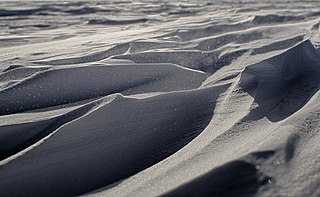 W
WSastrugi, or zastrugi, are features formed by erosion of snow by wind. They are found in polar regions, and in snowy, wind-swept areas of temperate regions, such as frozen lakes or mountain ridges. Sastrugi are distinguished by upwind-facing points, resembling anvils, which move downwind as the surface erodes. These points usually lie along ridges perpendicular to the prevailing wind; they are steep on the windward side and sloping to the leeward side. Smaller irregularities of this type are known as ripples or wind ridges.
 W
WA shore lead is an oceanographic term for a waterway opening between pack ice and shore. While the gap of water may be as narrow as a tide crack if closed by wind or currents, it can be as wide as 1,000 feet (300 m). Its formation can be influenced by tidal action, or subsurface conditions, such as current and ocean floor. Commonly, a shore lead is navigable by surface vessels.
 W
WSlush, also called slush ice, is a slurry mixture of small ice crystals and liquid water.
 W
WA snow flurry is a light snowfall that results in little or no snow accumulation. The US National Weather Service defines snow flurries as intermittent light snow that produces no measurable precipitation. In contrast, bursts of snowfall that do result in measurable snow accumulation are called snow showers.
 W
WThe climatic snow line is the boundary between a snow-covered and snow-free surface. The actual snow line may adjust seasonally, and be either significantly higher in elevation, or lower. The permanent snow line is the level above which snow will lie all year.
 W
WA snowdrift is a deposit of snow sculpted by wind into a mound during a snowstorm. Snowdrifts resemble sand dunes and are formed in a similar manner, namely, by wind moving light snow and depositing it when the wind has virtually stopped, usually against a stationary object. Snow normally crests and slopes off toward the surface on the windward side of a large object. On the leeward side, areas near the object are a bit lower than surrounding areas, but are generally flatter.
 W
WA snowsquall, or snow squall, is a sudden moderately heavy snow fall with blowing snow and strong, gusty surface winds. It is often referred to as a whiteout and is similar to a blizzard but is localized in time or in location and snow accumulations may or may not be significant.
 W
WSuncups are bowl-shaped open depressions into a snow surface, normally wider than they are deep. They form closely packed, honeycomb, often hexagonal patterns with sharp narrow ridges separating smoothly concave hollows. For a given set of suncups, the hollows are normally all around the same size, meaning that the pattern is quasi-periodic on 20–80 cm scales. The depressions are typically 2–50 cm deep.
 W
WThundersnow, also known as a winter thunderstorm or a thundersnowstorm, is an unusual kind of thunderstorm with snow falling as the primary precipitation instead of rain. It typically falls in regions of strong upward motion within the cold sector of an extratropical cyclone. Thermodynamically, it is not different from any other type of thunderstorm, but the top of the cumulonimbus cloud is usually quite low. In addition to snow, graupel or hail may fall as well.
 W
WWhiteout, white-out, or milky weather is a weather condition in which the contours and landmarks in a snow-covered zone become almost indistinguishable. It could be also applied when visibility and contours are greatly reduced by sand. The horizon disappears from view while the sky and landscape appear featureless, leaving no points of visual reference by which to navigate; there is absence of shadows because the light arrives in equal measure from all possible directions. Whiteout has been defined as: "A condition of diffuse light when no shadows are cast, due to a continuous white cloud layer appearing to merge with the white snow surface. No surface irregularities of the snow are visible, but a dark object may be clearly seen. There is no visible horizon."
 W
WA winter storm is an event in which varieties of precipitation are formed that only occur at freezing temperatures, such as snow, mixed snow and rain, or freezing rain—rain that encounters frozen surfaces. In temperate continental climates, these storms are not necessarily restricted to the winter season, but may occur in the late autumn and early spring as well. Very rarely, they may form in summer, though it would have to be an abnormally cold summer, such as the summer of 1816 in the Northeastern United States.
 W
WA waterspout is an intense columnar vortex that occurs over a body of water. Some are connected to a cumulus congestus cloud, some to a cumuliform cloud and some to a cumulonimbus cloud. In the common form, it is a non-supercell tornado over water.